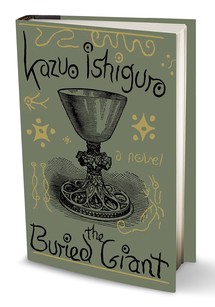Before we meet anyone else in
The Buried
Giant, Kazu Ishiguro's long-awaited return to the novel, we're introduced
to an "I" and a "you." The "I" is the
narrator—one intimately familiar with the mythic, post-Arthurian Britain that's
to be the landscape of the tale—the "you" is us. Or at least the
version of us that can believe in the ogres and pixies who will be in
attendance along with an aging Sir Gawain and the dragon he's been circling for
years. We believe in them not only because Ishiguro is an enchanter, but
because we're always believed, raised as we were on fairy tales—whose presence
here feels not like left-field fantasy, but essential truth borne of humanity's
deepest wishes and fears.
As Axl and Beatrice, the elderly couple at the book's heart, set forth to find their grown son, they're hampered by a heavy mist that holds all of Britain under an amnesic spell. A she-dragon named Querig is producing the gray cloud, and before long the duo is diverted, along with a Saxon warrior and a young boy, onto a journey to slay her. This is a quest in the most traditional sense, and yet when the odyssey is complete, the results are far more modern, more ambiguous—more Ishiguro—than tradition would dictate. Was there, after all, a benefit to the mist? Can the country's fragile peace and even Axl and Beatrice's love, survive without it?
Fans of Ishiguro's earlier work will be prepared for his splendidly disconcerting conclusion. As the cloud lifts in the book's final pages and the characters begin recalling past pain and loss and love, we start remembering things we've known all along as well. Namely, that there are at least two reasons we read: to be entertained, and to be shaken to the core. And perhaps a third: that we still after all these years, need someone to sit us down and tell us a fairy tale.


